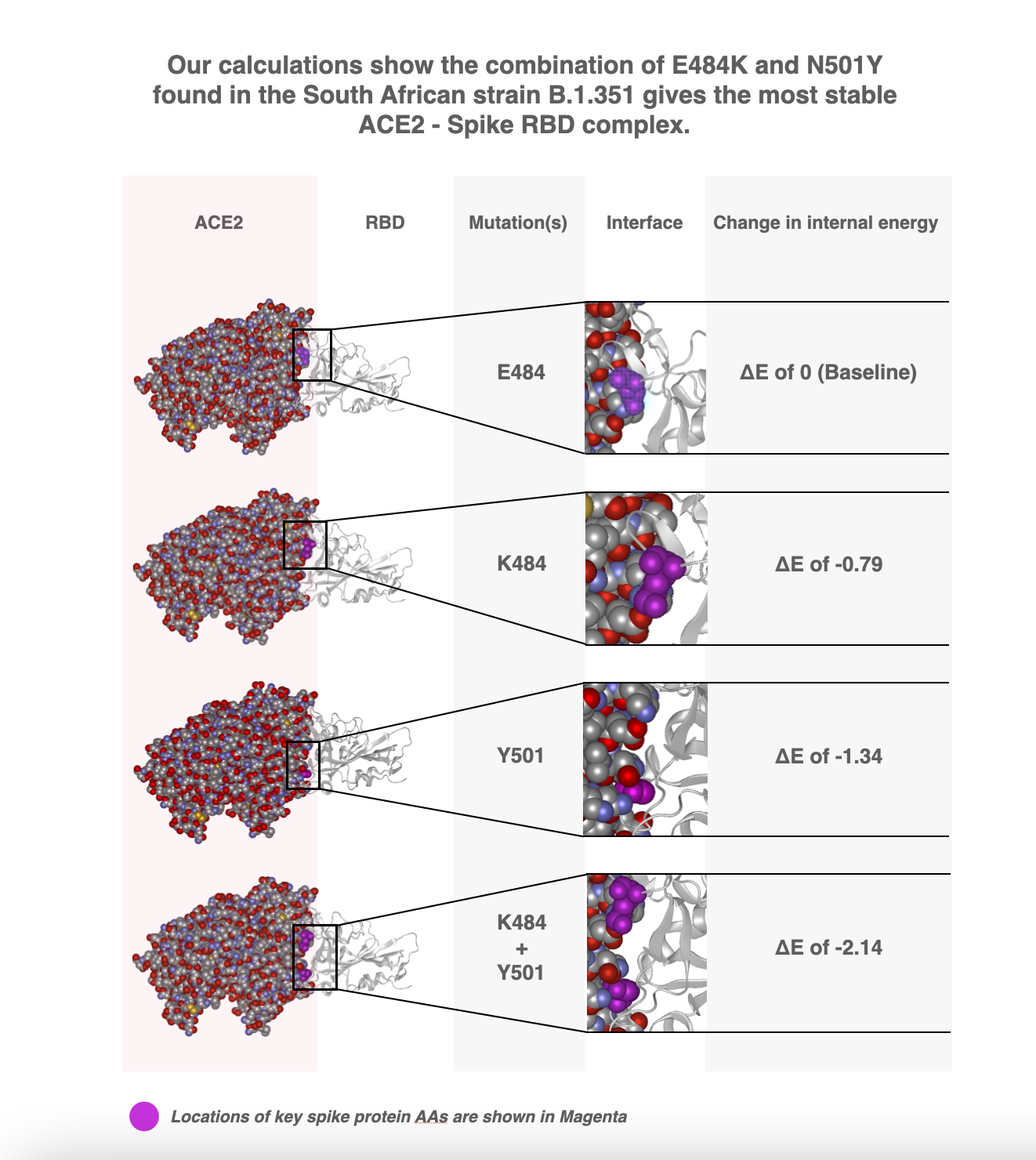3 min read
Modeling the Impact of the UK and South African Strain Mutations
Mutations Found in the South African and UK COVID-19 Virus Strains Improve the Stability of the ACE2-Spike RBD Complex
Back in December, we reported on the SARS-CoV-2 spike protein-ACE2 receptor structure of a United Kingdom strain of the virus. Designated B.1.1.7, it appears to be more transmissible than original isolates of the virus. The B.1.1.7 lineage has a mutation — designated N501Y — in the receptor-binding domain (RBD) of the spike protein at position 501, where amino acid asparagine (N) has been replaced with tyrosine (Y).
In South Africa, a highly transmissible variant of SARS-CoV-2 (designated B.1.351), has emerged independently of B.1.1.7. Cases attributed to this variant have been detected in multiple countries outside of South Africa and recently in South Carolina and Maryland here in the U.S. This variant shares some mutations with B.1.1.7, notably N501Y as well as the mutations K417N and E484K. One of these mutations, E484K, found in the receptor-binding domain, has been called an “escape mutation” since it lowers neutralization by polyclonal human serum antibodies found in convalescent serum1. Both the E484K and N501Y mutations lie at the interface between the ACE2 and RBD.
Using our in-house protein docking software, we modeled the interaction of ACE2 with the spike protein of the original, UK and South African strains. The spike protein structure of the original strain has amino acid E484 that has mutated to K484 in the South African strain. The UK and South African strains have the Y501 amino acid mutated from N501 in the original virus. We measured the impact of the original and mutants on the binding energy of the spike protein and ACE2 receptor.
Using the binding energy of the E484 (and N501) construct as the baseline (i.e., Δ of 0), we calculated the impact of the mutations. The K484 RBD showed a change in internal energy of the system (Δ) of -0.79 indicating a more stable ACE2-spike RBD complex. Similarly, the Y501 RBD showed a more stable Δ of -1.34. Combining the K484 and the Y501 mutation to the RBD further enhanced the stability of the complex with a Δ of -2.14. Thus, the presence of both mutations in our model of the South African B.1.351 strain shows the most stable ACE2-Spike RBD complex compared to models of the original and UK B.1.1.7 strain of the virus.

Currently, there is no evidence to suggest that this variant has any impact on disease severity. However, our finding of a more stable complex suggests that the South African strain would have a higher affinity for ACE2 receptor, thus improving its potency and leading to higher rates of transmission. The presence of the E484K and N501Y mutations in the South African virus appears to affect two mechanisms of virus transmission (e.g., ACE2 receptor binding and neutralizing Ab production). The rise of these mutations in the SARS-CoV-2 spike protein portends continuing challenges to develop effective vaccines and therapeutics to the evolving virus.
We’ll continue to publish additional findings from our SARS-CoV-2 research, and we encourage you to please let us know what you’re discovering in your studies.
____________
References:
1 “Comprehensive mapping of mutations to the SARS-CoV-2 receptor-binding domain that affect recognition by polyclonal human serum antibodies.” A. Greaney, A. Loes, K. Crawford, T. Starr, K. Malone, H. Chu, J. Bloom. bioRxiv 2020.12.31.425021

Author of more than 40 publications, John’s current research interests include new technologies for improving therapeutic antibody discovery, properties of next-generation antibody-like molecules, and best practices for critical reagents used in biologics development.



